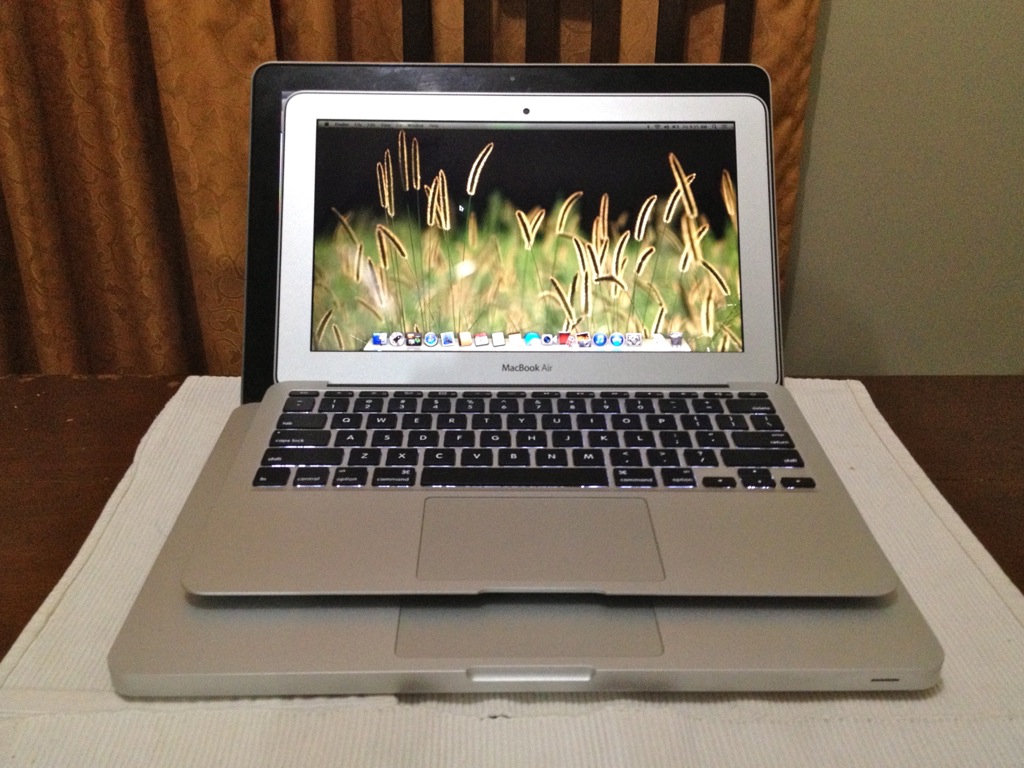Michelle needed a computer for her research, and Jeanne iPad mini just doesn’t cut it. So we decided that I get her an early ;) Christmas present: A MacBook Air. It’s small and light, the perfect ultraportable. As expected, build quality of the aluminum unibody is excellent. It has a 1.3GHz dual-core processor, 4GB of RAM, and 128GB of SSD storage. And most importantly for an ultraportable, it uses the Intel Haswell architecture which has been especially great in terms of battery life.
Last week, I decided to upgrade the memory of my MacBook Pro from 4GB to 8GB. I did my research and then went to Villman which is my usual go to place for hardware components. Ever since their humble beginnings with Boyet at the People’s Park, I’ve almost always gone for Villman. Lucky for me, they got the modules that I asked for.
When I got home, I excitedly swapped the old memory modules with the new ones. It won’t boot! I rechecked my research and it turned out that I was wrong. I got PC3-12800 (DDR3 1600 MHz) modules when I should have gotten PC3-8500 (DDR3 1066 MHz). Bummer.
So I went back to Villman and returned the memory modules. They didn’t have PC3-8500 modules but they told me they can order replacements which should be available in 5-15 days. It was quick and painless. And that is why I always come back to Villman.
So today, eight days after ordering, Villman called me that my memory has been delivered to the store. I had no plans of going out but I just had to go and pick them up. Michelle and Jeanne went with me to get snacks. As soon as we got home, I (still) excitedly swapped the old memory modules with the news ones. And this time, it booted up perfectly. And performed whoa so much faster. Memory is definitely the best bang-for-the-buck upgrade!
One word that Apple always uses against Android is the F word. Not the one that rhymes with ‘Duck’. I’m referring to ‘Fragmentation’. They’re referring to so many Android phones from so many manufacturers with so many different features (e.g. screen sizes), and to top it off, so many versions of the core OS with different “skins” applied by manufacturers to, you know, differentiate themselves. They say it like it’s what will bring about the end of Android and that Apple doesn’t have it.
But fragmentation has already been with iOS since the original iPad release back in April 2010. It’s just that iOS 3.2 then came with a built-in mechanism for supporting apps with non-dynamic UIs (upscaling). The same mechanism was used by iOS 4 when the iPhone 4 and its 640×960 display came out.
Most developers quickly came up with updates that target the iPad and the iPhone Retina display. Now with the iPhone 5 and its 640×1136 display it will be the same: iOS 6 comes with a built-in mechanism (letterboxing) and developers will quickly come up with updates that target the new display.
For most developers and even some customers, fragmentation is not a big deal. It’s nothing new. Just look back at Windows and PCs: A huge variety of hardware? Use device drivers. An assortment of resolutions? Use dynamic layouting. Different graphics chips? Use OpenGL or Direct3D. Been there, done that. Survived.
For many customers, it is a big deal and quite scary. But that’s just what fragmentation is: a scare word that Apple marketing came up with. If you’re afraid, maybe you can use a better word: ‘Diversity’. Doesn’t sound scary anymore, yeah?
I have no computer, much more a network connection, at the new office I’m deployed to so I’m forced to use my netbook and phone for surfing and downloading. Needless to say, having both WiFi and HSDPA activated is a huge drain on the battery. So I looked around for a USB charger.
The first logical place to go to is of course your friendly neighborhood Nokia service center. They had some but at a staggering P1,200. Next stop, was CD-R King, purveyor of cheap electronica where I endured a somewhat slow queue only to be told that they sell them for P90 but are currently out of stock. I finally found it at Games and Gadget for P220. Not as cheap as CD-R King but it sure beats out-of-stock.
Now I can extend my surfing to as long as my netbook has power and as long as I can stomach the expensive telco charges.
64-bit processor technology has been with us for quite some time. The first 64-bit processor, the MIPS R4000, came out in 1991. Back then they were expensive and relagated to server duty. Intel’s first 64-bit processor, the Itanium, came out in 2001 followed by AMD’s Opteron/AMD64 in 2003 starting the move to mainstream computing.
Now, the technology is practically everywhere, even desktops and laptops, with the Intel and AMD having multiple 64-bit processor families. And yet a lot of people still don’t know this. They have this impression that all desktops are 32-bit and only servers are 64-bit. But that’s not the case anymore.
Oh, and if you do have a 64-bit machine, do install a 64-bit OS, so you can harness your machine’s full potential. You wouldn’t want to have 8GB or RAM onboard only to find that your OS can’t use it.
